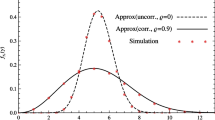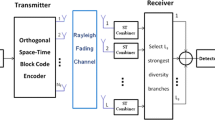Abstract
In this paper, we present a simplified maximum likelihood detection metric for the newly emerging space-time block codes (STBCs) with generalized coordinate interleaved orthogonal design (GCIOD). We also derive the symbol pairwise error probability (PEP) and the union bound on symbol error rate (SER) for a space-time block coded (STBCed) system with single-symbol detection and rotated QAM scheme over flat Rayleigh fading channels. In particular, linear STBCs with complex orthogonal design (COD) and GCIOD are considered. Based on the theoretical analysis, the symbol PEP of the GCIOD codes is related to the transmit power, signal-to-noise ratio, and the rotated angle of the rotated QAM scheme. However, the symbol PEP of the COD code is irrelevant to the rotated angle. It is shown that simulation results match well with our analysis. Thus, the union bounds on SER can be applied to predict the performance of a STBCed system with adaptive code selection between the full-rate COD and GCIOD codes.
Similar content being viewed by others
References
Tarokh V., Jafarkhani H., Calderbank A. R. (1999) Space-time block coding for wireless communications: Performance results. IEEE Journal on Selected Areas in Communications 17: 451–460
Jankiraman M. (2004) Space-time codes and MIMO systems. Artech House, London
Khan Md. Z. A., Rajan B. S. (2006) Single-symbol maximum likelihood decodable linear STBCs. IEEE Transactions on Information Theory 52: 2062–2091
Taricco G., Viterbo E. (1996) Performance of component interleaved signal sets for fading channels. IEE Electronics Letters 32: 1170–1172
Liu H. Y., Yen R. Y. (2006) Error probability for orthogonal space-time block code diversity system using rectangular QAM transmission over Rayleigh fading channels. IEEE Transactions on Signal Processing 54: 1230–1241
Shin, H., & Lee, J. H. (2002). Exact symbol error probability of orthogonal space-time block codes. In Proceedings of the IEEE GLOBECOM, Taipei, Taiwan (Vol. 2, pp. 1197–1201).
Simon M. K., Alouini M.-S. (2000) Digital communication over fading channels. Wiley, New York
Niida S., Inoue T., Takeuchi Y. (2004) Takeuchi performance of adaptive coding by selection of space-time block code matrix. IEEE VTC 2004-Fall 4: 2424–2428
Wei, Y. R. (2007). Efficient antenna selection schemes for MIMO systems, Chap. 6. Ph.D. Thesis, The Hong Kong Polytechnique University, Hong Kong.
Proakis J. G. (2001) Digital communications. McGraw-Hill, New York
Author information
Authors and Affiliations
Corresponding author
Rights and permissions
About this article
Cite this article
Wei, Y.R., Wang, M. Analysis of Single-Symbol Detectable Space-Time Block Codes With COD and GCIOD. Wireless Pers Commun 56, 315–331 (2011). https://doi.org/10.1007/s11277-009-9834-9
Published:
Issue Date:
DOI: https://doi.org/10.1007/s11277-009-9834-9




